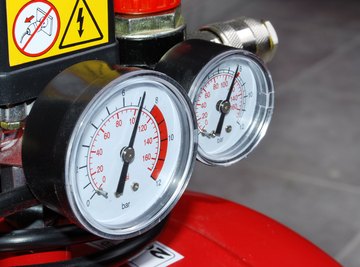
Rotary and reciprocating compressors are both components of gas transfer systems. They both have the same purpose--to bring a gas into the system, exhale exhaust, then repeat the process. They both do this by changing the pressure at certain points in order to force gas in and exhaust out.
Pistons
One key difference is that reciprocating compressors use pistons while rotary compressors do not. A reciprocating compressor has a piston move downwards, reducing pressure in its cylinder by creating a vacuum. This difference in pressure forces the cylinder door to open and bring gas in. When the cylinder goes back up, it increases pressure, thus forcing the gas back out. The up-and-down motion is called a reciprocating motion, hence the name.
Rollers
Rotary compressors, on the other hand, use rollers. They sit slightly off-center in a shaft, with one side always touching the wall. As they move at high speeds, they accomplish the same goal as the reciprocating compressors--one part of the shaft is always at a different pressure than the other, so gas can come in at the low pressure point and exit at the high pressure point.
Advantages and Disadvantages
Reciprocating compressors are marginally more efficient than rotary compressors, generally being able to compress the same amount of gas with between 5 and 10 percent less energy input. However, since this difference is so marginal, most small-to-medium level users are best off using a rotary compressor. Reciprocating compressors are more expensive and require more maintenance, so it is often not worth the extra cost and headache for such a small difference in efficiency.
Large users, however, are generally best-served by reciprocating compressors. These are users for whom 5 percent represents a substantial figure, often substantial enough to justify the added expense.
References
About the Author
Sam Grover began writing in 2005, also having worked as a behavior therapist and teacher. His work has appeared in New Zealand publications "Critic" and "Logic," where he covered political and educational issues. Grover graduated from the University of Otago with a Bachelor of Arts in history.
